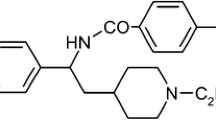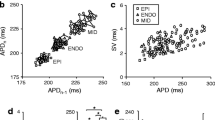We studied the frequency dependence of the effects of the novel Russian class III antiarrhythmic drug refralon on the duration of action potentials (AP) in rabbit ventricular myocardium. The absence of an inverse frequency dependence of AP prolongation was demonstrated: the effects of refralon at stimulation frequency of 1 Hz were stronger than at 0.1 Hz. The patch-clamp experiments with recording of rapid delayed rectifier potassium current IKr in a heterologous expression system showed that the blocking effect of refralon developed significantly faster at 2 Hz depolarization frequency than at 0.2 Hz. This feature of refralon distinguishes it among the majority of other class III drugs (sotalol, dofetilide, E-4031) and explains the relatively high safety of this drug together with its high efficacy.
Similar content being viewed by others
References
Maykov EB, Yuricheva YA, Mironov NY, Sokolov SF, Golitsyn SP, Rosenshtraukh LV, Chazov EI. Efficacy of a new class III drug niferidil in cardioversion of persistent atrial fibrillation and flutter. J. Cardiovasc. Pharmacol. 2014;64(3):247-255. doi: https://doi.org/10.1097/FJC.0000000000000112
Yuricheva YuA, Sokolov SF, Golitsyn SP, Mironov NYu, Rivin AE, Berman MV, Shubik YuV, Zotova IV, Zateyshchikov DA, Bolotova MN, Rozenshtraukh LV, Chazov EI. A novel III class antiarryhthmic, Niferidil, as an effective medication for the sinus rhythm recovery in patients with persistent atrial fibrillation. Vestnik Aritmol. 2012;(70):32-43. Russian.
Falk RH, Pollak A, Singh SN, Friedrich T. Intravenous dofetilide, a class III antiarrhythmic agent, for the termination of sustained atrial fibrillation or flutter. Intravenous Dofetilide Investigators. J. Am. Coll. Cardiol. 1997;29(2):385-390. doi: https://doi.org/10.1016/s0735-1097(96)00506-2
Nørgaard BL, Wachtell K, Christensen PD, Madsen B, Johansen JB, Christiansen EH, Graff O, Simonsen EH. Efficacy and safety of intravenously administered dofetilide in acute termination of atrial fibrillation and flutter: a multicenter, randomized, double-blind, placebo-controlled trial. Danish Dofetilide in Atrial Fibrillation and Flutter Study Group. Am. Heart J. 1999;137(6):1062-1069. doi: https://doi.org/10.1016/s0002-8703(99)70363-7
Galperín J, Elizari MV, Chiale PA, Molina RT, Ledesma R, Scapín AO, Blanco MV, Bonato R, Lago M; Grupo de Estudio de Fibrilación Auricular Con Amiodarona (GEFACA) Investigators. Pharmacologic reversion of persistent atrial fibrillation with amiodarone predicts long-term sinus rhythm maintenance. J. Cardiovasc. Pharmacol. Ther. 2003;8(3):179-186. doi: https://doi.org/10.1177/107424840300800302
Mironov NYu, Yuricheva YuA, Vlodzyanovskiy VV, Sokolov SF, Dzaurova KhM, Golitsyn SP, Shubik YuV, Berman MV, Medvedev MM, Rivin AE, Parkhomchuk DS, Barybin AE, Balandin DA, Batalov RE, Terekhov DS, Evstifeev IV, Kildeev IR, Pyataeva OV, Zenin SA. Safety and effectiveness of pharmacologic conversion of atrial fibrillation and flutter: results of multicenter trial. Part I: study rationale, design and assessment of effectiveness. Rats. Farmakoter. Kardiol. 2021;17(2):193-199. Russian. doi: https://doi.org/10.20996/1819-6446-2021-03-05
Mironov NYu, Yuricheva YuA, Vlodzyanovskiy VV, Sokolov SF, Dzaurova KhM, Golitsyn SP, Shubik YuV, Berman MV, Medvedev MM, Rivin AE, Parkhomchuk DS, Barybin AE, Balandin DA, Batalov RE, Terekhov DV, Evstifeev IV, Kildeev IR, Pyataeva OV, Zenin SA. Safety and effectiveness of pharmacologic conversion of atrial fibrillation and flutter: results of multicenter trial. Part II: assessment of safety. Rats. Farmakoter. Kardiol. 2021;17(5):668-673. Russian. doi: https://doi.org/10.20996/1819-6446-2021-10-06
Abramochkin DV, Kuzmin VS, Rosenshtraukh LV. Effects of new class III antiarrhythmic drug niferidil on electrical activity in murine ventricular myocardium and their ionic mechanisms. Naunyn Schmiedebergs Arch. Pharmacol. 2015;388(10):1105-1112. doi: https://doi.org/10.1007/s00210-015-1146-x
Abramochkin DV, Kuzmin VS, Rosenshtraukh LV. A new class III antiarrhythmic drug niferidil prolongs action potentials in guinea pig atrial myocardium via inhibition of rapid delayed rectifier. Cardiovasc. Drugs Ther. 2017;31(5-6):525-533. doi: https://doi.org/10.1007/s10557-017-6762-x
Singh BN. Arrhythmia control by prolonging repolarization: the concept and its potential therapeutic impact. Eur. Heart J. 1993;14(Suppl. H.):14-23. doi: https://doi.org/10.1093/eurheartj/14.suppl_h.14
Carmeliet E. Use-dependent block of the delayed K+ current in rabbit ventricular myocytes. Cardiovasc. Drugs Ther. 1993;7(Suppl. 3):599-604. doi: https://doi.org/10.1007/BF00877626
Jurkiewicz NK, Sanguinetti MC. Rate-dependent prolongation of cardiac action potentials by a methanesulfonanilide class III antiarrhythmic agent. Specific block of rapidly activating delayed rectifier K+ current by dofetilide. Circ. Res. 1993;72(1):75-83. doi: https://doi.org/10.1161/01.res.72.1.75
Surawicz B. Electrophysiologic substrate of torsade de pointes: dispersion of repolarization or early afterdepolarizations? J. Am. Coll. Cardiol. 1989;14(1):172-184. doi: https://doi.org/10.1016/0735-1097(89)90069-7
Abramochkin DV, Vornanen M. Seasonal acclimatization of the cardiac potassium currents (IK1 and IKr) in an arctic marine teleost, the navaga cod (Eleginus navaga). J. Comp. Physiol. B. 2015;185(8):883-890. doi: https://doi.org/10.1007/s00360-015-0925-5
Toyama J, Kamiya K, Cheng J, Lee JK, Suzuki R, Kodama I. Vesnarinone prolongs action potential duration without reverse frequency dependence in rabbit ventricular muscle by blocking the delayed rectifier K+ current. Circulation. 1997;96(10):3696-3703. doi: https://doi.org/10.1161/01.cir.96.10.3696
Author information
Authors and Affiliations
Corresponding author
Additional information
Translated from Byulleten’ Eksperimental’noi Biologii i Meditsiny, Vol. 174, No. 11, pp. 565-571, November, 2022
Rights and permissions
Springer Nature or its licensor (e.g. a society or other partner) holds exclusive rights to this article under a publishing agreement with the author(s) or other rightsholder(s); author self-archiving of the accepted manuscript version of this article is solely governed by the terms of such publishing agreement and applicable law.
About this article
Cite this article
Abramochkin, D.V., Pustovit, O.B., Mironov, N.Y. et al. The Dependence of the Electrophysiological Effects of Class III Antiarrhythmic Drug Refralon on the Frequency of Myocardium Activation. Bull Exp Biol Med 174, 610–615 (2023). https://doi.org/10.1007/s10517-023-05756-8
Received:
Published:
Issue Date:
DOI: https://doi.org/10.1007/s10517-023-05756-8




